Shear stress-induced mitochondrial biogenesis decreases the release of microparticles from endothelial cells
- PMID: 26024684
- PMCID: PMC4525091
- DOI: 10.1152/ajpheart.00438.2014
Shear stress-induced mitochondrial biogenesis decreases the release of microparticles from endothelial cells
Abstract
The concept of enhancing structural integrity of mitochondria has emerged as a novel therapeutic option for cardiovascular disease. Flow-induced increase in laminar shear stress is a potent physiological stimulant associated with exercise, which exerts atheroprotective effects in the vasculature. However, the effect of laminar shear stress on mitochondrial remodeling within the vascular endothelium and its related functional consequences remain largely unknown. Using in vitro and in vivo complementary studies, here, we report that aerobic exercise alleviates the release of endothelial microparticles in prehypertensive individuals and that these salutary effects are, in part, mediated by shear stress-induced mitochondrial biogenesis. Circulating levels of total (CD31(+)/CD42a(-)) and activated (CD62E(+)) microparticles released by endothelial cells were significantly decreased (∼40% for both) after a 6-mo supervised aerobic exercise training program in individuals with prehypertension. In cultured human endothelial cells, laminar shear stress reduced the release of endothelial microparticles, which was accompanied by an increase in mitochondrial biogenesis through a sirtuin 1 (SIRT1)-dependent mechanism. Resveratrol, a SIRT1 activator, treatment showed similar effects. SIRT1 knockdown using small-interfering RNA completely abolished the protective effect of shear stress. Disruption of mitochondrial integrity by either antimycin A or peroxisome proliferator-activated receptor-γ coactivator-1α small-interfering RNA significantly increased the number of total, and activated, released endothelial microparticles, and shear stress restored these back to basal levels. Collectively, these data demonstrate a critical role of endothelial mitochondrial integrity in preserving endothelial homeostasis. Moreover, prolonged laminar shear stress, which is systemically elevated during aerobic exercise in the vessel wall, mitigates endothelial dysfunction by promoting mitochondrial biogenesis.
Keywords: endothelial microparticle; exercise; mitochondrial biogenesis; shear stress.
Copyright © 2015 the American Physiological Society.
Figures

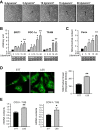
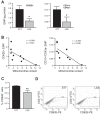

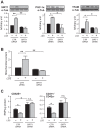
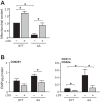
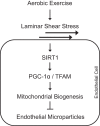
Similar articles
-
Dynamic mobilization of PGC-1α mediates mitochondrial biogenesis for the protection of RGC-5 cells by resveratrol during serum deprivation.Apoptosis. 2013 Jul;18(7):786-99. doi: 10.1007/s10495-013-0837-3. Apoptosis. 2013. PMID: 23525928
-
Mesenchymal stem cell-conditioned media ameliorate diabetic endothelial dysfunction by improving mitochondrial bioenergetics via the Sirt1/AMPK/PGC-1α pathway.Clin Sci (Lond). 2016 Dec 1;130(23):2181-2198. doi: 10.1042/CS20160235. Epub 2016 Sep 9. Clin Sci (Lond). 2016. PMID: 27613156
-
Exercise-mediated wall shear stress increases mitochondrial biogenesis in vascular endothelium.PLoS One. 2014 Nov 6;9(11):e111409. doi: 10.1371/journal.pone.0111409. eCollection 2014. PLoS One. 2014. PMID: 25375175 Free PMC article.
-
Turn up the power - pharmacological activation of mitochondrial biogenesis in mouse models.Br J Pharmacol. 2014 Apr;171(8):1818-36. doi: 10.1111/bph.12413. Br J Pharmacol. 2014. PMID: 24102298 Free PMC article. Review.
-
Regulation of SIRT1 in aging: Roles in mitochondrial function and biogenesis.Mech Ageing Dev. 2016 Apr;155:10-21. doi: 10.1016/j.mad.2016.02.003. Epub 2016 Mar 7. Mech Ageing Dev. 2016. PMID: 26923269 Review.
Cited by
-
Shear stress augments mitochondrial ATP generation that triggers ATP release and Ca2+ signaling in vascular endothelial cells.Am J Physiol Heart Circ Physiol. 2018 Nov 1;315(5):H1477-H1485. doi: 10.1152/ajpheart.00204.2018. Epub 2018 Aug 24. Am J Physiol Heart Circ Physiol. 2018. PMID: 30141983 Free PMC article.
-
Melatonin Promotes in vitro Development of Vitrified-Warmed Mouse GV Oocytes, Potentially by Modulating Phosphorylation of Drp1.Front Vet Sci. 2021 Sep 24;8:752001. doi: 10.3389/fvets.2021.752001. eCollection 2021. Front Vet Sci. 2021. PMID: 34631868 Free PMC article.
-
Healthy versus Unhealthy Adipose Tissue Expansion: the Role of Exercise.J Obes Metab Syndr. 2022 Mar 30;31(1):37-50. doi: 10.7570/jomes21096. J Obes Metab Syndr. 2022. PMID: 35283364 Free PMC article. Review.
-
Effects of Exercise on Extracellular Vesicles in Patients with Metabolic Dysfunction: a Systematic Review.J Cardiovasc Transl Res. 2023 Feb;16(1):97-111. doi: 10.1007/s12265-022-10282-5. Epub 2022 Jun 2. J Cardiovasc Transl Res. 2023. PMID: 35655108
-
The effect of extracellular vesicles on the regulation of mitochondria under hypoxia.Cell Death Dis. 2021 Apr 6;12(4):358. doi: 10.1038/s41419-021-03640-9. Cell Death Dis. 2021. PMID: 33824273 Free PMC article. Review.
References
-
- Ando J, Tsuboi H, Korenaga R, Takada Y, Toyama-Sorimachi N, Miyasaka M, Kamiya A. Shear stress inhibits adhesion of cultured mouse endothelial cells to lymphocytes by downregulating VCAM-1 expression. Am J Physiol Cell Physiol 267: C679–C687, 1994. - PubMed
-
- Ando J, Yamamoto K. Effects of shear stress and stretch on endothelial function. Antioxid Redox Signal 15: 1389–1403, 2011. - PubMed
-
- Ballinger SW, Patterson C, Knight-Lozano CA, Burow DL, Conklin CA, Hu Z, Reuf J, Horaist C, Lebovitz R, Hunter GC, McIntyre K, Runge MS. Mitochondrial integrity and function in atherogenesis. Circulation 106: 544–549, 2002. - PubMed
-
- Boulanger CM, Amabile N, Guerin AP, Pannier B, Leroyer AS, Mallat CN, Tedgui A, London GM. In vivo shear stress determines circulating levels of endothelial microparticles in end-stage renal disease. Hypertension 49: 902–908, 2007. - PubMed
-
- Boulanger CM, Amabile N, Tedgui A. Circulating microparticles: a potential prognostic marker for atherosclerotic vascular disease. Hypertension 48: 180–186, 2006. - PubMed
Publication types
MeSH terms
Substances
Grants and funding
LinkOut - more resources
Full Text Sources
Other Literature Sources
Medical

